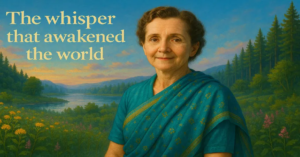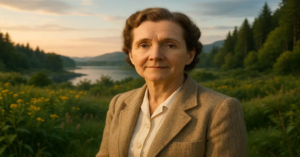Rachel Carson’s Silent Spring Legacy: How One Woman Sparked the Modern Environmental Movement
The Whisper That Awakened the World: Rachel Carson Quiet Revolution

Rachel Carson Ladybug and the Lightning Rod
The year is 1917. Spring Creek, Pennsylvania. A freckled 10-year-old Rachel Carson kneels in damp soil, her braids brushing the earth as she traces a ladybug’s journey across a milkweed leaf. Her mother Maria’s voice, soft as rustling sedge grass, whispers: “Watch how she moves—see the purpose in her journey? Every creature has its epic.”
In that moment, the child who would later ignite an environmental revolution learned her first law of ecology: Attention is reverence.On their 65-acre farm without electricity or plumbing, Maria transformed poverty into pedagogy:
-
They charted bird migrations like naval expeditions
-
Observed spiderwebs as “silken cathedrals”
-
Deciphered owl calls into a “nocturnal language”
“I was happiest with wild birds and creatures as companions,” Carson later wrote. This childhood of radical noticing became her superpower—the ability to see interconnections where others saw only resources.
By age 10, she’d published in St. Nicholas Magazine. At Pennsylvania College for Women, a biology class with Professor Mary Skinker ignited her dual vision: Science as truth-teller, writing as translator. She abandoned her English major, later noting: “I couldn’t separate the beauty of nature from its mechanics. The poetry was in the facts.”
🌊 Rachel Carson Sea’s Scribe: Where Science Wore Poetry
1932: Carson stands before the all-male hiring board at the U.S. Bureau of Fisheries…
At 25, armed with a master’s in zoology from Johns Hopkins, she’s applying to write radio scripts—the only position open to women. Her examination essay on marine life stuns them with lyrical precision. She’s hired as the second female professional in agency history. When it finally printed—days before Pearl Harbor—it vanished without notice. Carson bought six copies herself to keep it in print.
Then came the miracle.
June 1951: The Sea Around Us publishes. Within weeks, it hits #1. For 86 consecutive weeks, Carson’s oceanic odyssey dominates bestseller lists—outselling Hemingway and the Bible. The New Yorker serializes it; RKO Pictures adapts it for film; she wins the National Book Award.
“To stand at the edge of the sea is to know eternity.” — The Edge of the Sea (1955)
Rachel Carson sea trilogy fused taxonomic precision with spiritual awe:
| Book | Scientific Breakthrough | Lyrical Signature |
|---|---|---|
| Under the Sea Wind | First “biography” of non-human species | “The mackerel moved like liquid metal through the deep” |
| The Sea Around Us | Revealed continental drift theory to the public | “We carry oceans in our blood like a memory of home” |
| The Edge of the Sea | Cataloged 300+ Atlantic intertidal species | “The hermit crab carries its homelessness like a poem” |
☠️ The Poisoned Spring: A Dying Woman’s War on “Biocides”
January 1958: A letter arrives from Olga Owens Huckins: “After the DDT planes came, robins convulsed on our lawn. The marsh has gone silent.” Carson initially hesitated—she was battling breast cancer, caring for her orphaned 5-year-old grandnephew Roger, and nursing her 89-year-old dying mother. Then she visited the irradiated marshes.
What she witnessed became ecological horror:
*In Illinois: Earthworms absorbed DDT, poisoning robins mid-song
*In Alabama: Fish floated belly-up in chemical-slicked streams
*On Long Island: Children developed radiation-like burns after spraying
Her research uncovered darker truths:
*DDT manufacturers knew it caused liver tumors since 1946
*Workers at Montrose Chemical wore gas masks while filling spray tanks
*USDA officials received kickbacks from chemical companies
For four years, while undergoing radical mastectomies and radiation, Carson compiled evidence. Her “poison book” grew into 1,200 pages with 55 pages of citations. She called pesticides “biocides”—life-destroyers.
💣 Rachel Carson: “Hysterical Spinster” vs. Unshakeable Truth
| Attacker | Strategy | Quote |
|---|---|---|
| Monsanto | Published “The Desolate Year” parody | “Without pesticides, locusts devour America!” |
| Velsicol | Threatened Houghton Mifflin with lawsuit | “Her claims are scientifically baseless” |
| American Cyanamid | Funded “experts” to discredit her | “A fanatic defender of cult-nature” |
Personal attacks reached fever pitch:
-
Time Magazine: Called her “a hysterical spinster obsessed with cats”
-
Former USDA Secretary: “She’s probably a communist”
-
Oklahoma Senator: Later blocked her centennial tribute as “junk science”
The most insidious attacks weaponized her identity: “Of course she hates technology—no husband or children to protect!”
April 3, 1963: Carson walks into the Senate hearing room. Bald from chemo, her wig slightly askew, she takes the stand. When chemical lobbyists interrupt, Senator Ribicoff silences them: “Let the lady speak. She earned it.”
Her testimony—delivered in a voice as calm as still water—changed history:
“We spray poisons on our food as casually as seasoning salt. These chemicals now cycle through our streams, soil, and children’s bones. This isn’t just about dead birds—it’s about the right to be safe in our own world.”
CBS aired “The Silent Spring of Rachel Carson” to 15 million viewers. President Kennedy ordered his Science Advisory Committee to investigate. Their verdict: Carson was right on every count.
⚖️ The Ripple Effect: Rachel Carson Legacy in Laws and Wings
| Year | Landmark Victory | Direct Impact |
|---|---|---|
| 1970 | EPA established; First Earth Day | 20 million marched—largest U.S. protest ever |
| 1972 | U.S. bans DDT | Bald eagle rebounds from 417 to 11,040 pairs |
| 1973 | Endangered Species Act | Saves 99% of listed species from extinction |
| 1996 | Food Quality Protection Act | Requires pesticide testing for child safety |
🔍 The Unfinished War: Carson’s Warning in the Age of Neonics
| Modern “Biocide” | Carson Connection | Current Crisis |
|---|---|---|
| Neonicotinoids | 10,000x more toxic than DDT to bees | 90% decline in U.S. monarch butterflies since 1990 |
| Glyphosate | Found in 80% of U.S. urine samples | 98% decline in frog populations in sprayed areas |
| PFAS | “Forever chemicals” in 97% of American blood | Linked to infertility and immune damage |
🌍 Why Rachel Carson Whisper Still Thunders

🕊️ The Philosopher of Interbeing
- Against anthropocentrism: “Why should we value a warbler less than a warehouse?”
- For kinship: “The more clearly we focus our attention on the wonders of the universe, the less taste we shall have for destruction.”
- Precursor to systems thinking: Her food chain diagrams revealed ecology as neural network
💡 The Quiet Leadership Manifesto
| Trait | Her Example | Modern Parallel |
|---|---|---|
| Introverted Impact | Worked from Maine cottage, not D.C. podiums | Greta Thunberg’s solitary school strike |
| Radical Care | Wrote Silent Spring while adopting a child and nursing her dying mother | Vanessa Nakate uplifting African climate voices |
| Love as Fuel | 900 letters to Dorothy Freeman: “The tide pools restore me” | Robin Wall Kimmerer braiding sweetgrass wisdom |
🕯️ The Unsilenced Spring: Our Turn at the Tipping Point
Spring 1964: Carson lies dying as migrating warblers return to Maine. Too weak to lift binoculars, she whispers to Dorothy: “What I ache for is to last long enough to… see the spring.”
Sixty years later, her ache becomes our imperative.
Carson’s Armory for the 21st Century
Her life bequeaths three weapons:
- WONDER AS RESISTANCE
That child tracing ladybugs became the woman who felled chemical Goliaths. Reclaim:
* Bio-blitzing: Map urban biodiversity
* Phenology journals: Track climate shifts through bloom times
*Toxic tours: Document pollution hotspots
2.PRECISION AS POWER
She destroyed DDT with 57 pages of citations. Today’s toolkit:
*EPD Explorer: Track corporate emissions
*Toxics Release Inventory: Map local polluters
*Community air monitoring
3.THE UNYIELDING “I”
One dying woman faced the Senate. Your voice is a trench.
*Sue: Join youth climate lawsuits
*Divest: Move funds from fossil banks
*Rewild: Convert lawns to native prairies
The Chickadee’s Charge
When you hear that high fee-bee in morning stillness, remember: Carson called it “a tiny flame of being.” Extinguish it? Or:
-
Demand EPA liberation from lobbyist capture
-
Push for the Farm System Reform Act
-
Teach children to read oak leaves as “earth’s braille”
“We stand now where two roads diverge. The other fork offers our last chance to reach a destination that assures the preservation of the earth.”
— Silent Spring
Sixty years later, her ache becomes our imperative.
The quiet revolution continues—one unsprayed garden, one policy battle, one awakened child at a time. What will you add to Rachel Carson’s unfinished spring? 🌸
Leave a Reply
Want to join the discussion?Feel free to contribute!